#readingcomprehension
Explore tagged Tumblr posts
Text
The Importance of Reading Worksheets and Comprehension Passages for Kids
Introduction
In today’s fast-paced digital world, where screens dominate our lives, fostering a love for reading in children has become more important than ever. Reading not only enhances language skills but also stimulates imagination, promotes critical thinking, and broadens knowledge. One effective tool in developing these abilities is the use of reading worksheets and comprehension passages. These resources provide children with structured exercises that encourage active reading, comprehension, and engagement. This article explores the significant benefits of incorporating reading worksheets and comprehension passages into a child’s learning journey.
Enhancing Reading Skills
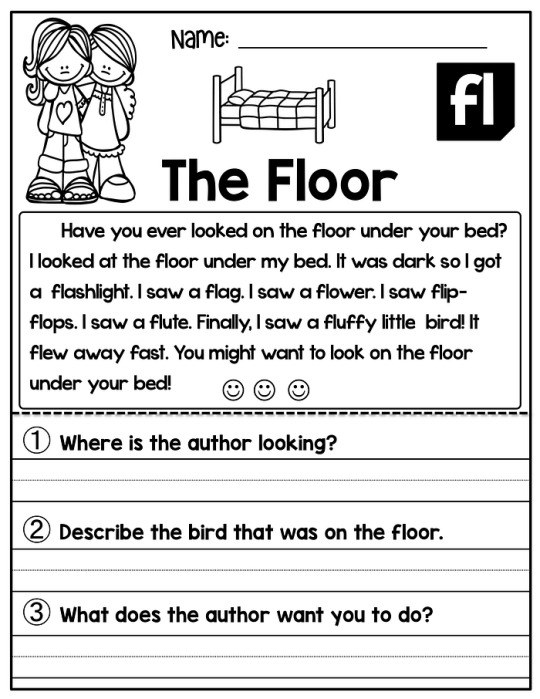
2. Promoting Critical Thinking
Critical thinking is an invaluable skill that empowers children to analyze, evaluate, and interpret information effectively. Reading worksheets and comprehension passages encourage critical thinking by challenging children to delve deeper into the text. By asking thoughtful questions and prompting reflection, these resources prompt children to analyze characters, infer motives, and make connections between different ideas. The process of solving problems, drawing conclusions, and forming opinions strengthens children’s ability to think critically, ultimately benefiting their academic and personal lives.
3. Developing Vocabulary and Language Skills
Expanding a child’s vocabulary is essential for effective communication and comprehension. Reading worksheets and comprehension passages expose children to a diverse range of words and phrases, helping them build their vocabulary. These resources often incorporate contextual clues and exercises that encourage children to infer word meanings, fostering independent learning. By repeatedly encountering new words in various contexts, children develop a strong foundation in language skills, enabling them to express themselves eloquently and comprehend complex texts.
4.Fostering Comprehension and Retention
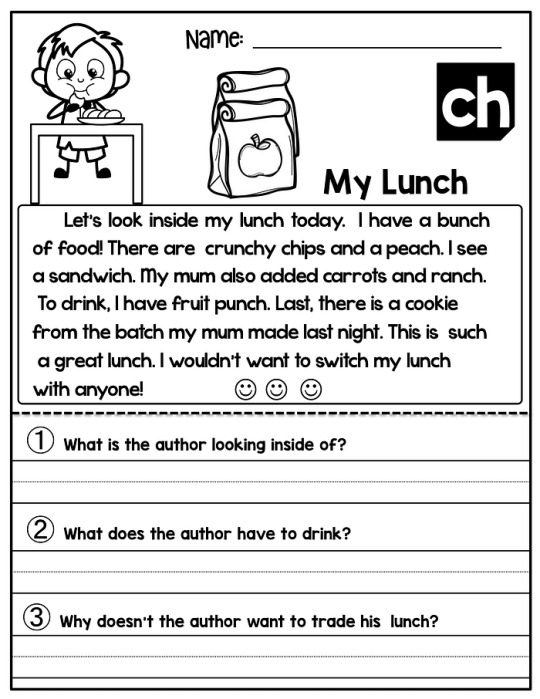
5. Cultivating a Love for Reading
Perhaps the most significant advantage of reading worksheets and comprehension passages is their potential to ignite a love for reading in children. When presented with engaging and age-appropriate texts, children can explore various genres, discover new worlds, and develop a genuine enthusiasm for reading. As they experience the joy of immersing themselves in stories and information, their motivation to read independently grows. This love for reading extends beyond the confines of worksheets, encouraging children to explore books, literature, and other forms of written material.
Conclusion
Reading worksheets and comprehension passages serve as invaluable tools in nurturing vital skills, such as reading proficiency, critical thinking, vocabulary development, and comprehension. By actively engaging children in the reading process, these resources enhance their overall cognitive abilities and foster a lifelong love for reading. Incorporating reading worksheets and comprehension passages into a child’s learning routine can pave the way for academic success, improved communication skills, and a well-rounded personality. Let us embrace these resources as an essential part of a child’s educational journey, guiding them toward a future filled with knowledge, imagination, and endless possibilities.
Get Kindergarten Reading Worksheets
#Reading#ReadingWorksheets#ComprehensionPassages#KidsReading#ReadingSkills#ReadingComprehension#EarlyLiteracy#LiteracySkills#EducationalResources#KidsEducation#ReadingActivities#LearningThroughReading#ChildDevelopment#ParentingTips#TeachingKids#EducationMatters#ReadingIsFundamental#EducationalTools#HomeSchooling#StudySkills#LearningResources#ChildrensBooks#ReadingMotivation#ReadingHabits
2 notes
·
View notes
Text

Master the IPMAT English & RC Sections with Confidence! 🌟 Build a strong vocabulary, sharpen grammar, and ace reading comprehension with practice and strategy. Stay consistent, stay motivated, and achieve your dream of joining prestigious institutes like IIM Indore and IIM Rohtak! 📚✨
1 note
·
View note
Text

The Big Book of Writing Skills Activities
The Big Book of Writing Skills Activities, Grade 1: 120 Activities for After-School and Summer Writing Fun (Reading Comprehension Activities)
Go beyond other kids educational workbooks with:
120 Amazing activities―Get the most fun activities you'll find in workbooks for first graders, including drawing, storytelling, and fill-in-the-blanks that keep them engaged and interested in learning.
Essential skill development―Set your little one up for a lifetime of success as they learn how to make lists, use prepositions, properly place commas, write stories, and more.
Progressive difficulty―Keep kids from getting frustrated with challenges that start simple and grow more difficult as they progress through the book and hone their skills.
Give your young learner a huge boost with one of the biggest and most effective
to get more information click on the link
for more products please visit
#BigBookOfWritingSkills#WritingActivities#Grade1Learning#ReadingComprehension#WritingFun#AfterSchoolActivities#SummerLearning#EarlyEducation#KidsWriting#ReadingForKids#TeacherResources#ElementaryEducation#LearningThroughFun#CreativeWritingForKids#Grade1Books#WritingSkills#ChildrensBooks#LearningActivities#BackToSchoolFun#EduBooks#BookRecommendationsForKids
0 notes
Video
English Reading Practice | Reading in 15 Minutes a Day- EP 01
#readingpractice #practicereadingenglish #readingcomprehension #readingenglish
0 notes
Text
ACTIVITIES TO IMPROVE READING COMPREHENSION SKILLS
–Triveni Goswami Vernal Registered Special Educator: CRR A64010The previous blog shed light on various type of Reading Comprehension and how each of them, together, made Reading Comprehension, a multi-layered, complex skill. In this blog, I will share activities to improve the various kinds of Reading Comprehension skills. 1) LEXICAL COMPREHENSION: For Lexical Comprehension, since the focus is…
0 notes
Text
Top Tips for Success in Online SAT Preparation
Here are some top tips for success in online SAT Classes that can help students achieve their desired scores:
Set Clear Goals and Deadlines
First of all, determine what range you would like to achieve and how long you are going to work towards it. Divide study goals into short-term and long-term to ensure that the student stays on track.
Create a Dedicated Study Schedule
Since online prep is periodic, choose a regular time to work on prep that is convenient for you. Spend a certain number of hours per day or per week on SAT preparation and do not forget about other commitments.

Choose the Right Online SAT Classes in Delhi
Not all courses are the same, so choose one that complements the way you learn, your time availability and purse strings. Ensure that the course involves many resources, sample testing and tutor’s assistance.
Focus on Weak Areas First
Initial diagnostic tests should be used in order to determine the positive and negative factors. Address your low performing areas, even if they may be math, English, reading, etc., while revising the section you excelled in.
Utilize High-Quality Study Resources
Use only authorized SAT practice material, tutorials, and SAT preparation books. Web sites such as Tathastu Education give free materials needed for SAT preparation.
Practice with Realistic Timed Tests
Use test-like conditions to resolve pacing issues and enhance performance on the actual tests. Timed practice is very important since it will assist the candidate familiarize with the stress of real examination environments.
Analyse Mistakes and Track Progress
After each test, review incorrect answers and understand your mistakes. Additional analysis can be achieved by comparing the scores over several time intervals in order to identify areas where scores have increased and where the area’s which still requires more practice.
Stay Engaged During Online SAT Classes
Attend online SAT coaching in Delhi and take an active part in them by asking questions and writing important information. Take questions and follow along with the instructor to ensure that their information is being stored into their memories.
Use Digital Tools for Vocabulary Building
Vocabulary doesn’t have a substantial importance in the SAT writing section though it is very important for the part of the SAT commonly referred to as reading. Use different apps for vocabulary and have the goal to read a certain amount of new words in a week.
Take Advantage of One-on-One Tutoring if Possible
One on one tutoring is a common feature in most online SAT coaching since this way it will be easier to not only guide an individual but also help solve tough sections within a shorter period.
Practice Maths Without a Calculator
There are questions on the SAT math section that are likely to be done without use of a calculator. To perform these without a calculator will enhance the speed and accuracy.
Stay Consistent and Avoid Procrastination
One of the weaknesses of online learning is that students may delay their work. Avoid procrastination, eat well, and take regular breaks, avoid last-minute cramming.
Take Regular Breaks to Avoid Burnout
Cramming and memorizing is not effective because working for long at a time depletes the person's energy. A plan should include short breaks during a day and longer breaks during the week so that emotions do not become exhausted and fuzzy.
Prepare for Test Day Logistics
Familiarize yourself with SAT test-day requirements, such as materials to bring and ID rules, to avoid unnecessary stress on the exam day.
Using the above mentioned tips, the students are able to get the best out of their online SAT coaching in Delhi as well as being able to score well.
Visit: https://tathastuedu.com/sat/
Instagram: https://www.instagram.com/tathastuedu/
Medium: https://ielts-coaching-in-delhi.medium.com/
WriteupCafe: https://writeupcafe.com/profile/tathastuedu/
Steemit: https://steemit.com/@studyabroad12
#SATexam#SATScore#SATinstitute#SATcoaching#SATinstitutenearme#CollegeBoard#StandardizedTesting#CollegeAdmissions#TestPrep#SATscores#HighSchool#Education#ScholasticAssessmentTest#SATprep#CollegeBound#AdmissionsTest#StudyTips#TestTaking#Math#Reading#Writing#Language#SATessay#mathskills#readingcomprehension#writingpractice#teststrategy
0 notes
Text

Unseen Passage for Class 9 CBSE with Answers
Unseen Passage for Class 9 CBSE with Answers: Practice reading comprehension with these important unseen passages, designed to improve understanding and exam preparation.
0 notes
Text
Top CAT Coaching Classes in Navi Mumbai

The Prayas India is widely regarded as one of the top CAT coaching classes in Navi Mumbai. Known for its experienced faculty, comprehensive study material, and personalized attention, it helps students excel in the CAT exam. The institute offers regular mock tests and flexible batch timings to accommodate different schedules. With a proven track record of success, The Prayas India is the preferred choice for serious CAT aspirants. Contact: 07710013217.
#ThePrayasIndia#CATCoaching#NaviMumbai#TopCATCoaching#CATPreparation#CATExam#MBAEntrance#BschoolDreams#CATSuccess#BestCATCoaching#MBAAspirants#StudySmart#QuantitativeAbility#VerbalAbility#ReadingComprehension#DataInterpretation#LogicalReasoning#MockTests#ExperiencedFaculty#PersonalizedAttention#FlexibleTimings#SuccessStories#CompetitiveExams#HigherEducation#CareerGoals#AchieveYourDreams
0 notes
Text
Understanding the Interactions Amongst the Characters

Introduction
Character interactions play a pivotal role in shaping the narrative landscape of any story. Whether in literature, film, or any form of storytelling, the dynamics between characters can significantly influence the audience's engagement. This article explores the nuances of character interactions, shedding light on their importance, factors influencing them, and practical ways to teach and assess these interactions.
Outline
- Introduction - Importance of Character Interactions - Enhancing Plot Development - Building Depth in Characters - Factors Influencing Character Interactions - Personality Traits - Motivations and Goals - Conflict and Resolution - Designing Engaging Character Interactions - Creating Realistic Dialogue - Utilizing Body Language - Incorporating Subtext - Role of Character Relationships - Friendships - Romantic Relationships - Antagonistic Relationships - Analyzing Character Relationships: A Comprehensive Guide - Teaching Character Interactions - Lesson Plan Overview - Activities and Exercises - Assessing Student Understanding - Evaluation Methods - Feedback and Improvement - Real-world Applications - Translating Fictional Skills to Reality - Professional and Social Implications - Case Studies - Successful Character Interactions in Literature - Lessons from Notable Authors - Common Mistakes to Avoid - Stereotyping Characters - Overloading Dialogues - The Impact of Character Interactions on Reader Engagement - Emotional Connection - Reader Investment - Conclusion - FAQs - Sources
Understanding the Interactions Amongst the Characters
Importance of Character Interactions
Enhancing Plot Development
Character interactions serve as the dynamic engine that propels the narrative forward, adding layers of complexity to the plot. Through well-crafted interactions, authors have the power to introduce unexpected twists, intricate conflicts, and satisfying resolutions. Engaging the audience in the ebb and flow of character dynamics ensures that the story remains compelling and unpredictable. A plot driven by meaningful interactions not only captures the reader's attention but also keeps them eagerly anticipating the next turn of events.
Building Depth in Characters
Beyond merely advancing the storyline, character interactions play a crucial role in sculpting the depth and authenticity of the individuals within the narrative. The way characters engage with each other provides readers with a unique vantage point into their personalities, motivations, and inner worlds. By observing how characters respond to challenges, express their emotions, and navigate relationships, readers gain profound insights into their strengths, weaknesses, and idiosyncrasies. These nuances contribute to creating characters that extend beyond mere protagonists and antagonists, evolving into individuals with whom the audience can empathize and connect.
Factors Influencing Dynamic Interactions
Understanding the factors that influence character interactions is paramount in creating authentic and compelling scenarios within a story. A character's personality traits, motivations, and the overarching conflict are pivotal in shaping how they engage with the world around them. Personality Traits Each character brings a unique set of traits to the narrative, influencing how they interact with others. An extroverted, charismatic character might engage in lively and expressive interactions, while an introverted character may express themselves more subtly. Exploring this diversity enriches the overall tapestry of character dynamics. Motivations and Goals Character interactions are deeply intertwined with the motivations and goals driving each individual. Whether fueled by love, ambition, or a desire for revenge, these motivations become the driving force behind characters' choices and interactions. Understanding these underlying motives adds depth and authenticity to the narrative. Conflict and Resolution Conflict, a fundamental element of storytelling, significantly impacts character interactions. How characters navigate conflicts and seek resolutions not only influences the plot's trajectory but also reveals essential aspects of their personalities. The nuanced handling of conflict and resolution contributes to the overall richness of character dynamics.
Factors Influencing Character Interactions
Personality Traits
In the intricate dance of character interactions, the distinctive personality traits of each individual act as the choreography, determining the rhythm and style of their engagements. An introverted character, characterized by introspection and reserved demeanor, might opt for subtle and nuanced interactions. On the flip side, an extroverted character, fueled by outward expression, may engage in lively and expressive interactions. Exploring this spectrum of traits enriches the narrative, infusing it with authenticity and allowing readers to connect more deeply with the characters.
Motivations and Goals
At the heart of compelling character interactions lie their motivations and goals. Understanding the driving forces behind a character's actions provides a roadmap to deciphering their interactions. Whether propelled by love, ambition, or the pursuit of revenge, these motivations become the invisible threads weaving the tapestry of relationships within a story. Characters with conflicting motivations can spark intense and intriguing interactions, driving the narrative forward with a sense of purpose and tension.
Conflict and Resolution
In the grand theater of storytelling, conflict takes center stage, and character interactions often become the battleground for these dramatic confrontations. How characters navigate and resolve conflicts is a lens through which their personalities and values are refracted. The choices made in the heat of disagreement or the aftermath of a clash reveal crucial facets of a character's nature. Skillful handling of conflict and resolution not only advances the plot but also provides opportunities for character growth, adding depth and complexity to the narrative.
Designing Engaging Character Interactions
Creating Realistic Dialogue
In the intricate tapestry of character interactions, dialogue is the thread that weaves authenticity into the narrative. Crafting realistic dialogue is an art that involves capturing the cadence, nuances, and idiosyncrasies of human speech. Characters should speak in a manner that aligns with their personalities, backgrounds, and the context of the story. Whether it's the witty banter between friends, the terse exchanges in a heated argument, or the tender words exchanged between lovers, well-crafted dialogue immerses readers in the world of the characters, making the narrative more relatable and engaging.
Utilizing Body Language
Communication extends far beyond spoken words, and character interactions gain depth when writers pay attention to the language of the body. Subtle cues such as a furrowed brow, a nervous fidget, or a confident stance can convey emotions and intentions more vividly than words alone. By incorporating body language into character interactions, writers create a multi-sensory experience for readers. This attention to detail not only enriches the storytelling but also provides an additional layer for readers to interpret and connect with the characters on a more profound level.
Incorporating Subtext
The space between words often speaks louder than the words themselves, and this is where subtext comes into play. Characters may not always express their true thoughts and feelings explicitly; there's an art to what remains unsaid. Mastering subtext allows writers to convey the unspoken tensions, desires, or hidden agendas that simmer beneath the surface of interactions. It adds complexity to characters, making them more intriguing and the narrative more layered. Readers, attuned to the subtle dance of subtext, find themselves engaged in deciphering the deeper currents of the story, enhancing their overall reading experience.
Role of Character Relationships
Friendships
Friendships in storytelling serve as a dynamic force that shapes characters and propels the narrative forward. The bonds formed between characters provide a foundation of support, camaraderie, and shared experiences. Whether it's the laughter shared in moments of joy or the steadfast support during times of crisis, well-crafted friendships breathe life into the narrative. These relationships can also introduce elements of challenge and growth, as friends may hold each other accountable or navigate conflicts. Friendships add a layer of authenticity to characters, making them more relatable to readers who recognize the nuances of genuine connections.
Romantic Relationships
Romantic interactions are a cornerstone of character relationships, infusing stories with passion, tension, and emotional depth. From the delicate dance of flirtation to the complexities of long-term commitments, the spectrum of romantic relationships offers a vast canvas for storytelling. Exploring the dynamics between characters in love allows writers to delve into the intricacies of human emotion. Whether it's the slow burn of a developing romance or the stormy clashes in a tumultuous relationship, these interactions contribute to the overarching themes of the narrative, creating a memorable and emotionally resonant reading experience.
Antagonistic Relationships
Antagonists, whether they are external foes or internal conflicts, are pivotal in character interactions. The confrontations and clashes between characters and their antagonistic forces drive the plot forward, creating tension and suspense. Examining how characters navigate these adversarial relationships provides insight into their strengths, vulnerabilities, and growth arcs. The resolution of antagonistic conflicts can be as crucial as their emergence, shaping the characters and the overall trajectory of the story. Well-crafted antagonistic relationships add layers of complexity to the narrative, keeping readers invested in the characters' journeys.
Analyzing Character Relationships: A Comprehensive Guide
Analyzing character relationships in literature is a nuanced process that involves delving into the dynamics, motivations, and implications of interactions between characters. To perform a thorough analysis, one must consider several key elements. 1. Observation of Interactions Begin by closely observing how characters engage with each other. Note the frequency, tone, and context of their interactions. Look for patterns or changes in behavior over the course of the narrative. 2. Exploration of Motivations Understanding the motivations driving characters is essential. Examine their goals, desires, and fears. Character motivations significantly influence how they relate to others within the story. 3. Examination of Conflict and Resolution Character relationships often evolve through conflict and resolution. Analyze the nature of conflicts, how characters navigate them, and the impact on their relationships. Resolutions can provide insights into the depth of connections. 4. Assessment of Dialogue and Non-Verbal Cues Character relationships are often conveyed through dialogue and non-verbal cues. Analyze the subtleties of conversations, paying attention to what is said versus what is implied. Consider body language, gestures, and expressions to unearth hidden dynamics. 5. Consideration of Changes Over Time Characters and their relationships may undergo transformations. Track the evolution of relationships throughout the narrative, identifying pivotal moments that shape the characters' connections. 6. Evaluation of External Influences External factors can significantly impact character relationships. Analyze how societal, cultural, or environmental elements contribute to or hinder the development of connections. 7. Recognition of Symbolism Authors often use symbolism to convey deeper meanings in character relationships. Explore symbolic elements within the narrative that enhance the understanding of connections. In conclusion, a comprehensive analysis of character relationships involves a multidimensional approach, considering various aspects of interactions, motivations, conflicts, and symbolic elements. This process not only unveils the intricacies of relationships but also provides a richer understanding of the narrative as a whole.
Teaching Character Interactions
Lesson Plan Overview Crafting a lesson plan on character interactions necessitates a comprehensive understanding of the intricacies involved in character dynamics. The plan begins by exploring fundamental psychological principles that underpin human relationships. By delving into concepts such as communication styles, personality traits, and the impact of motivations, students gain insights into how these aspects shape fictional characters. Additionally, the plan incorporates an analysis of literary examples that exemplify effective character interactions. By dissecting well-crafted narratives, students can identify and appreciate the techniques employed by seasoned authors in portraying engaging relationships. Activities and Exercises The effectiveness of the lesson plan lies in its hands-on approach, offering students practical experiences to solidify their comprehension of character interactions. Role-playing activities immerse students in the minds and emotions of the characters they create, allowing them to apply psychological concepts in a dynamic setting. Group discussions stimulate critical thinking as students analyze and compare the character interactions present in various literary works. Creative writing exercises then empower students to experiment with different scenarios, fostering creativity and honing their ability to construct authentic and compelling character relationships. Through these activities, students not only grasp theoretical concepts but also cultivate practical skills in character development and interaction.
Assessing Student Understanding
Evaluation Methods Effectively evaluating students' understanding of character interactions involves employing a variety of assessment methods. Assignments that require students to create and analyze character interactions in written form assess their ability to apply theoretical knowledge. Quizzes, both written and oral, test their comprehension of key concepts such as dialogue, conflict, and subtext. Peer reviews introduce an interactive element, allowing students to evaluate and learn from each other's work. The combination of these evaluation methods provides a holistic view of each student's proficiency in grasping the nuanced elements of character interactions. Feedback and Improvement Constructive feedback is an integral component of the learning process. After assessments, providing detailed feedback on students' strengths and areas for improvement helps them understand their progress. Encouraging students to revisit and revise their work based on feedback cultivates a mindset of continuous improvement. This iterative process not only hones their understanding of character interactions but also instills a sense of resilience and determination. The goal is to create an environment where students perceive feedback as a valuable tool for enhancing their skills, fostering a culture of ongoing learning and development.
Real-world Applications
Translating Fictional Skills to Reality The skills cultivated through understanding character interactions in fiction possess real-world applicability. Effective communication, a cornerstone of compelling character interactions, is a transferable skill applicable in various professional and personal contexts. As students engage with fictional characters and their intricate relationships, they are inadvertently honing their abilities to communicate clearly, empathize, and navigate complex social dynamics. Professional and Social Implications The implications of understanding character interactions extend beyond the realm of storytelling, permeating professional and social spheres. Proficiency in deciphering and crafting character relationships fosters a heightened sense of empathy, a crucial asset in both personal and professional relationships. The ability to discern underlying motivations, navigate conflicts, and communicate effectively becomes a valuable skill set. In workplaces, employees equipped with these interpersonal skills often contribute to healthier team dynamics and enhanced collaboration. Socially, individuals adept at understanding character interactions may find it easier to relate to and connect with others, enriching their personal lives. The lessons learned from fictional character interactions serve as a practical guide for navigating the intricacies of the human experience, adding depth and nuance to both professional and personal interactions.
Case Studies
Successful Character Interactions in Literature Examining successful character interactions in literature unveils a treasure trove of storytelling techniques. Case studies of renowned works not only showcase the depth and complexity authors infuse into their characters but also reveal the impact these interactions have on the overall narrative. For instance, the intricate relationships in Jane Austen's novels, such as the spirited exchanges between Elizabeth Bennet and Mr. Darcy in "Pride and Prejudice," showcase how well-crafted character interactions can elevate a story, creating memorable and engaging experiences for readers. Lessons from Notable Authors Delving into the works of notable authors provides a rich source of lessons for aspiring writers seeking to master the art of character interactions. Studying the approaches of literary giants like Gabriel Garcia Marquez, who intricately weaves characters into the fabric of magical realism, or J.K. Rowling, who expertly crafts the relationships in the Harry Potter series, offers invaluable insights. These authors employ diverse techniques—from nuanced dialogue to subtle gestures—that breathe life into characters and make their interactions resonate with readers. Aspiring writers can glean inspiration and practical guidance from these masters, learning how to create compelling characters whose interactions drive the narrative forward. Whether exploring the romantic entanglements in classic literature or dissecting the friendships and conflicts in contemporary works, case studies serve as a blueprint for understanding the nuanced art of character interactions. Read the full article
#Characterdevelopment#characterinteractions#lessonplan#literaryanalysis#readingcomprehension#storyelements#writingskills
0 notes
Text
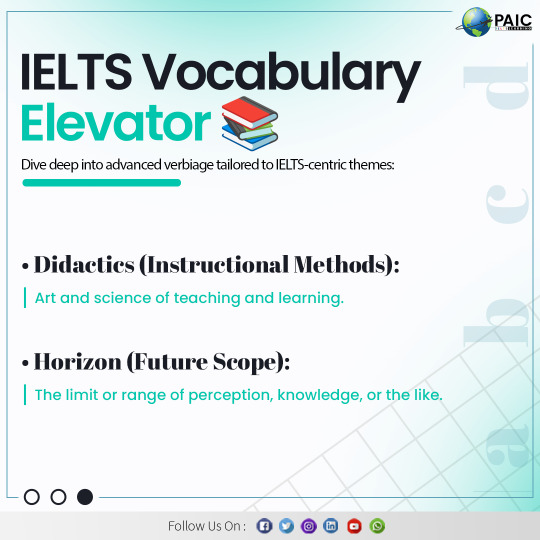
"Explore, Engage, Empower: Daily Info Insights Await! . .
#ieltslearning#explore#engage#empower#dailyinsights#paicieltslearning#vocabulary#FluentSpeech#ieltsspeaking#VocabularyBoost#readingcomprehension
0 notes
Text
Conquering Math Anxiety: Unlocking Academic Success


Young boy studying math in class. Photo by Woodley Wonder Works. Flickr.
Math Anxiety: Embracing Numbers with Confidence
Overcoming Fear of Numbers Many children worldwide experience math anxiety—an unsettling fear or stress linked to math tasks. This anxiety can be debilitating, discouraging young learners from confidently approaching math problems. The fear of making a mistake often stands as a barrier to effective math learning. Symptoms of Math Anxiety Math anxiety can manifest in various ways, including nervousness, dread, or even physical symptoms like sweaty palms or an accelerated heart rate when confronted with math-related tasks. These emotions can create mental blocks, making it challenging for students to grasp mathematical concepts and apply them effectively. Empowering Young Learners Addressing math anxiety necessitates a supportive and empathetic approach. Teachers and parents play a vital role in helping children overcome this hurdle. Breaking down complex problems into smaller, manageable steps and reinforcing effort rather than merely correct answers can gradually build math confidence, empowering young learners to embrace numbers with confidence.
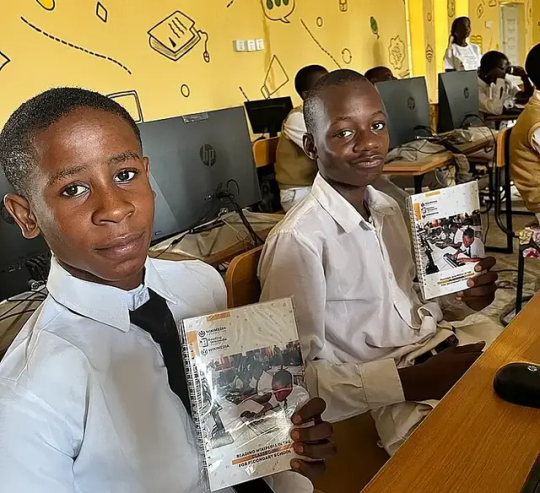
Reading Wikipedia in the Classroom for Secondary School Students. Photo by James Rhoda. Wikimedia.
Reading Comprehension: Beyond Words
Unlocking the Meaning Behind Text Reading goes beyond decoding words; it involves comprehending the deeper meaning behind them. Reading comprehension is a multifaceted skill, requiring the ability to analyze, infer, and synthesize information from text. Navigating Reading Challenges Children who struggle with reading comprehension may accurately decode words but often struggle to connect the dots between sentences and paragraphs. This challenge can hinder their performance across various subjects. Enhancing Reading Comprehension To address this challenge, educators and parents worldwide can employ strategies that focus on enhancing reading comprehension skills. This may include asking questions to stimulate critical thinking, promoting discussions about the material, and exposing children to diverse genres and topics to broaden their understanding of the text.
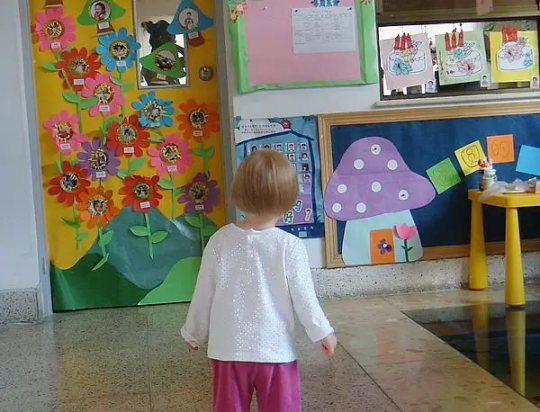
What are they doing in there... Photo by Scott & Elaine van der Chijs. Flickr.
Nurturing a Love for Learning: Sustaining Interest
Fostering Curiosity and Engagement Maintaining a child's interest in subjects like math and reading is crucial. When young learners lose interest, their enthusiasm and effort may wane, hampering their academic progress. Sparking Passion for Learning Educators and parents worldwide can ignite a passion for learning by introducing engaging and relevant content. Math and reading need not be perceived as dry or abstract subjects; instead, they can serve as tools for exploring the world. Real-world examples, hands-on activities, and literature that resonates with children's interests can make a significant difference in fostering a love for learning.

Young girl showing the mental struggles that come with dyslexia. Photo by Kristine Lewis. Flickr.
Facing Unique Learning Challenges
Learning Disabilities: Overcoming Obstacles Specific learning disabilities like dyslexia or dyscalculia can make it extremely challenging for children to excel in reading and math. These disabilities affect how children process information, making it difficult for them to acquire and apply essential skills. Early Identification and Support Recognizing the signs of learning disabilities is crucial for early intervention. Teachers and parents globally should be attentive to indicators such as difficulty in reading fluently, problems with number concepts, or persistent struggles despite adequate instruction. Once identified, specialized support and strategies can be implemented to help children with learning disabilities thrive academically.

Oceanway Middle School on Earth Day with a new outdoor classroom. Photo by JAXPORT. Flickr.
Bridging the Opportunity Gap: Equal Access to Education
Limited Resources: Equalizing Opportunities Socioeconomic disparities can lead to unequal access to quality educational resources and tutoring, depriving disadvantaged children worldwide of essential support. Ensuring Equity in Education Addressing this issue requires a collaborative effort from communities, schools, and policymakers across the globe. Initiatives to bridge the opportunity gap, such as providing free or low-cost educational resources, offering after-school programs, and ensuring equitable access to quality schools, can make a substantial impact. By leveling the playing field, we can help all children reach their academic potential, regardless of their socioeconomic background.

Academic Achievement Award. Photo by Hugo y Charli. Flickr.
Building Blocks for Success: Academic Achievement
Math and Reading Proficiency: A Path to Success Proficiency in math and reading serves as the cornerstone of a child's educational journey, regardless of geographical location. These skills are not confined to specific subjects but serve as essential tools for understanding and excelling in various disciplines worldwide. Unlocking a World of Opportunities In today's interconnected world, strong math and reading skills open doors to a myriad of professions and career paths. From STEM (Science, Technology, Engineering, and Mathematics) fields to literature, social sciences, and more, a solid foundation in math and reading unlocks a world of opportunities for children worldwide.

Soon Amandine got more and more confident. Photo by Sebastien Bertrand. Flickr.
Building Confidence and Self-esteem
Empowering Personal Growth Continual academic struggles can erode a child's self-confidence and self-esteem, impacting their overall well-being. Education is not just about acquiring knowledge; it's also about fostering a sense of self-worth and confidence in one's abilities. Fostering Resilience and Self-Belief Children worldwide need a supportive atmosphere where making mistakes and seeking help are encouraged. Promoting a growth mindset, where effort and perseverance are valued over innate abilities, can boost a child's self-confidence and motivation to improve. Recognizing that mistakes are opportunities for growth enables them to become more resilient learners.

Poverty and kindness of the child. Photo by Bibek Gaire. Wikimedia.
Breaking Cycles of Poverty: The Economic Impact
Education as a Catalyst for Change Insufficient proficiency in math and reading can have a lasting economic impact, contributing to cycles of poverty worldwide. Education is a powerful tool for breaking this cycle, but academic struggles can impede progress. Leveling the Playing Field As children from diverse backgrounds aim for academic success, it's essential to address these challenges. Early intervention, access to quality resources, and equitable opportunities can empower young learners globally to reach their full potential and break free from the constraints of poverty. Sources: THX News, National Report Card & National Center for Education Statistics. Read the full article
#Academicachievement#Buildingconfidence#Earlyintervention#EconomicImpact#Engaginglearning#Learningdisabilities#Mathanxiety#Mathreading#Qualityresources#Readingcomprehension#Supportiveenvironment
0 notes
Text
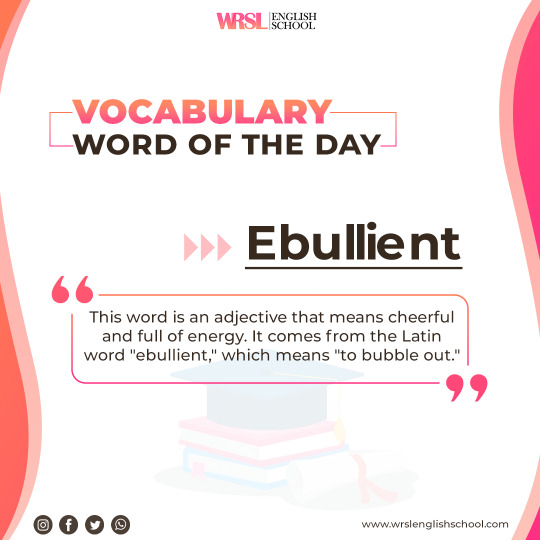
IELTS Vocabulary Tips for Effective Communication!
Learn More:- https://www.wrslenglishschool.com/ielts-prep/learn-vocabulary-related-to-ELTS-topics-quickly
#ReadToSucceed#VocabularyBoost#FlashcardsForVocabulary#PracticeMakesPerfect#TestTakingStrategies#wrsl#SynonymsAndAntonyms#WordVariety#AcademicVocabulary#FormalWriting#ContextClues#ReadingComprehension#wrslenglishschool
0 notes
Text
Types of Dyslexia
Dyslexia is a complex learning disorder that affects reading, writing, and spelling skills. Here are a few types or sub types of dyslexia worth understanding:
Phonological Dyslexia: Difficulties in recognizing and manipulating the sounds of spoken language (phonemes) can impact decoding and spelling skills.
Surface Dyslexia: Challenges with visual aspects of reading, particularly recognizing whole words by sight. Individuals may rely heavily on phonological decoding strategies.
Rapid Naming Dyslexia: Difficulty quickly and accurately retrieving and naming visual symbols or objects, such as letters or numbers. Reading fluency and symbol-related tasks may be affected.
Dysgraphia: Writing and handwriting difficulties that often co-occur with reading challenges. Issues with legibility, spelling, and organizing thoughts into written form.
Deep Dyslexia: A rare form of dyslexia involving semantic errors during reading. Difficulty with word recognition and comprehension due to semantic substitutions.
#PhonologicalProcessing#ReadingDifficulties#SightWordReading#WordRecognition#NamingSpeed#SymbolRecognition#WritingDifficulties#Handwriting#ReadingComprehension
0 notes
Text
TYPES OF READING COMPREHENSION
-Triveni Goswami VernalRegistered Special Educator: CRR A64010The previous blog (https://specialsaathi.com/2024/10/24/reading-comprehension-and-autism/) shed light on the significant role of Visualization in Reading Comprehension for individuals on the Autism Spectrum. In this blog, we will look at the various types of Reading Comprehension—Lexical Comprehension, Literal Comprehension,…
0 notes
Text
Why Coaching for the SAT is important Part 1
The SAT exam plays a significant role in college admissions, particularly for students looking to study in top universities abroad. With new generations of students' dreams of making it to universities in other countries by seeking higher education, it has become crucial to prepare for the SAT exam effectively in India. This is something that coaching institutes for SAT fill in the gaps for by providing structural elements, supervision as well as materials to allow the students to get the best results. Here’s why SAT coaching is important and why Selecting the best SAT coaching institute in Delhi can make a difference in scoring high results .
1. Structured Curriculum and Expert Guidance
Another advantage of SAT coaching is that they come along and provide a well-organised curriculum tailored to cover all the aspects of the exam, whether it is under the Reading, Writing, or Math section. Some institutes like Tathastu Education, the Best SAT Institute in Delhi divide them according to the components to ensure they offer a roadmap that students can follow. By having expert instructors explain the course content, students can avoid unnecessary detours and focus on the skills and concepts that matter most. Many of these professionals have years of teaching experience, their input may help a student know how to prepare to get the desired results on test day.
2. Access to Exclusive Practice Resources
Majority of the Sat preparations deal with practice, where SAT coaching institutes often have access to exclusive practice materials that replicate real SAT questions. The best SAT coaching in Delhi provides these, full length and section-wise tests, quizzes and mock tests to expose the students with the structure of the examination so that they can strategize their way through each section. Continuous practice under exam-like conditions also reduces test-day anxiety, helping students stay calm and focused.

3. Personalized Feedback and Performance Analysis
In the SAT coaching program Students get feedback once they complete a test or assignment and they get it personally. The Best SAT Coaching in Delhi is more about analyzing each student’s strengths and weaknesses, providing tailored feedback that helps them improve specific areas. For example, a student who may struggle with time management in the Math section can receive tips and strategies from experienced tutors, allowing for targeted improvement.
Visit: https://tathastuedu.com/sat/
Instagram: https://www.instagram.com/tathastuedu/
Medium: https://ielts-coaching-in-delhi.medium.com/
WriteupCafe: https://writeupcafe.com/profile/tathastuedu/
Steemit: https://steemit.com/@studyabroad12
#SATexam#SATScore#SATinstitute#SATcoaching#SATinstitutenearme#CollegeBoard#StandardizedTesting#CollegeAdmissions#TestPrep#SATscores#HighSchool#Education#ScholasticAssessmentTest#SATprep#CollegeBound#AdmissionsTest#StudyTips#TestTaking#Math#Reading#Writing#Language#SATessay#mathskills#readingcomprehension#writingpractice#teststrategy
0 notes
Text
The Importance of Sight Words Worksheets: Building the Foundation for Reading Success
Introduction
Sight words, also known as high-frequency words, are the most commonly used words in the English language. These words often do not follow regular phonetic patterns and cannot be easily decoded. Teaching children to recognize sight words by sight is essential for developing reading fluency and comprehension. Sight words worksheets provide a structured and effective method to introduce, practice, and reinforce these critical words. In this article, we will explore the importance of sight words worksheets in building a strong foundation for reading success.
Improving Reading Fluency
Reading fluency is the ability to read with accuracy, speed, and expression. Sight words worksheets focus on repetitive exposure to high-frequency words, enabling children to recognize and read them effortlessly. By practicing sight words through worksheets, children become familiar with these words, which enhances their reading speed and automaticity. Fluency in recognizing sight words allows young readers to devote more attention to understanding the overall meaning of the text, leading to improved reading comprehension.
2. Enhancing Vocabulary and Comprehension
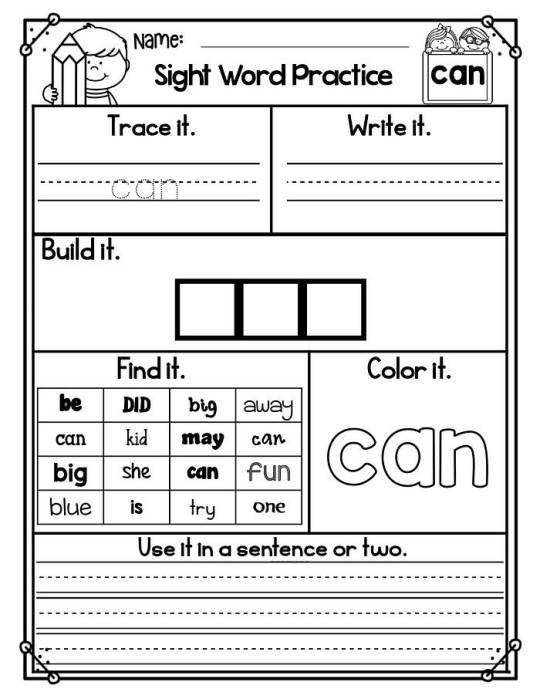
3. Building Confidence and Motivation
Learning sight words through worksheets offers a structured and measurable approach to mastery. As children progress through different levels of sight words, they experience a sense of accomplishment and build confidence in their reading abilities. The visual and interactive nature of sight words worksheets keeps children engaged and motivated, as they can actively participate in activities like word searches, fill-in-the-blanks, and matching exercises. The incremental progress they make on their sight word journey reinforces their confidence, encouraging them to take on more challenging reading tasks.
4. Supporting Independent Reading
Sight words are frequently encountered in early reading materials, such as leveled readers and beginning storybooks. By mastering sight words through worksheets, children acquire the skills necessary for independent reading. Recognizing sight words instantly allows young readers to focus their energy on decoding unfamiliar words and comprehending the overall text. The ability to independently read and understand sight words empowers children to engage with age-appropriate books and develop a love for reading.
5. Establishing a Strong Foundation for Literacy
Sight words serve as building blocks for reading and writing proficiency. Mastery of sight words lays the foundation for more advanced reading skills, such as phonics, decoding, and comprehension. Sight words worksheets provide a structured framework for introducing and reinforcing these foundational words, ensuring that children have a solid base on which to build their literacy skills. As children progress in their reading journey, their mastery of sight words will continue to support their development as confident and competent readers.
Conclusion
Sight words worksheets play a crucial role in developing reading fluency, enhancing vocabulary, and building a strong foundation for literacy skills. These worksheets provide targeted practice and repetition, allowing children to recognize and internalize high-frequency words effortlessly. By incorporating sight words worksheets into early reading instruction, we equip children with the tools they need to become proficient readers. As they gain confidence in reading and understanding sight words, children develop a solid foundation for lifelong literacy, opening doors to knowledge, imagination, and a world of opportunities.
Get Sight Words Worksheets
#SightWords#ReadingSuccess#ReadingSkills#LiteracyDevelopment#EarlyEducation#ReadingFoundations#LanguageSkills#ReadingReadiness#ReadingComprehension#PhonicsSkills#WordRecognition#VocabularyBuilding#ReadingFluency#EarlyLiteracy#EducationalTools#LearningResources#ReadingSupport#LiteracySkills#TeachingMaterials#LanguageDevelopment#EducationalBenefits#ReadingStrategies#ReadingPrograms#ParentingTips#ReadingMotivation#EarlyChildhoodEducation#LiteracySuccess#ReadingMilestones#EducationalAdvancement#TeachingMethods
1 note
·
View note